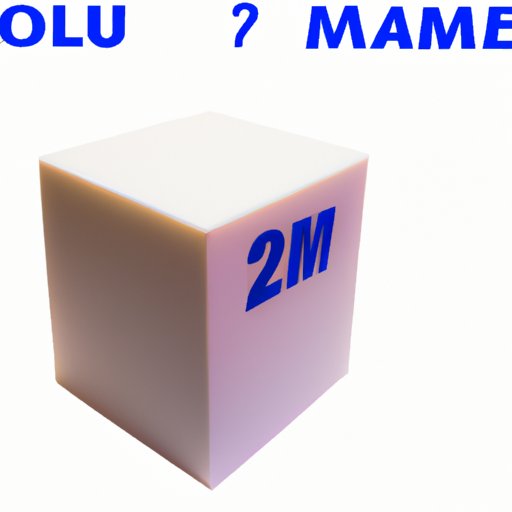I. Introduction
A cube is a three-dimensional object that has six equal sides and angles. Finding the volume of a cube is important in various fields from science to construction. In this article, we will explain the basics of calculating cube volume, provide step-by-step instructions, and discuss practical applications of this skill in real life scenarios.
II. The Basics of Calculating Cube Volume For Beginners
Volume is the amount of space occupied by a three-dimensional object. While area measures the space covered by a two-dimensional figure, volume measures the space occupied by a three-dimensional shape. The formula for finding the volume of a cube is V = s^3, where s is the length of one of the cube’s sides.
For example, if a cube has sides that are each 5 cm long, we can calculate its volume as follows:
V = s^3 = 5^3 = 125 cubic centimeters.
When finding the volume of a cube, it is important to remember that all of the sides are equal.
Common mistakes beginners make when calculating cube volume include forgetting to cube the side length in the formula and using the wrong units of measurement. To avoid these mistakes, double-check your work and always use consistent units of measurement.
III. Mastering the Formula: A Step-by-Step Guide to Calculate Cube Volume
To calculate the volume of a cube, you first need to know the length of one of its sides. Using a ruler or a tape measure, measure one side of the cube from one end to the other.
Once you have the length of one side, you can use the formula V = s^3 to find the volume. Let’s try an example:
Suppose a cube has sides that are each 2 cm long. We can calculate its volume as follows:
V = s^3 = 2^3 = 8 cubic centimeters.
If the sides are measured in different units (e.g. feet and inches), convert them to the same unit before calculating the volume.
It is also important to note that the formula for cube volume can be used to find the volume of other rectangular prisms, as long as all six sides have right angles.
To practice your skills, try solving these problems:
1. A cube has sides that are 6 mm long. What is its volume?
2. A rectangular prism has sides that measure 3 cm, 4 cm, and 5 cm respectively. What is its volume?
3. A cube has sides that are each 2 ft long. What is its volume in cubic inches?
IV. From Classroom to Real Life: Practical Applications of Cube Volume Calculation
The ability to calculate the volume of a cube has practical applications in many fields. For example:
– When packing boxes, it is necessary to calculate the volume of the objects to ensure that they will fit in the box.
– When filling a pool, it is necessary to know how much water the pool can hold.
– In construction, the volume of materials needed for a cube-shaped structure must be calculated.
For irregularly shaped objects, the formula can be adapted by dividing the object into smaller cubes and adding up their volumes.
V. Making Math Fun: 5 Engaging Activities to Teach Cube Volume to Kids
Learning about cube volume can be exciting and hands-on for children. Here are some activities to help teach this concept:
1. Building with blocks or Legos to create cube-shaped structures and measuring their volumes.
2. Guessing the volume of objects around the house, then measuring them to see who was closest.
3. Playing a game where the child has to guess how many smaller cubes are needed to fill a larger cube, then testing their guess.
4. Using modeling clay to create cube-shaped objects, then measuring their volumes.
5. Estimating the amount of water needed to fill a container of familiar shape (e.g. a plastic storage container), then calculating the volume to see how close the estimate was.
By making math fun and interactive, children will be more likely to remember how to calculate cube volume.
VI. The Math of Construction: How to Calculate the Volume of Cube-Shaped Structures
Calculating the volume of cube-shaped structures is important in construction. Contractors need to know the volume of materials needed for a project before they begin, such as concrete for a foundation or drywall for interior walls.
When working with larger structures, additional considerations need to be taken into account. For example, space for doors and windows must be factored into the calculations, as this will affect the volume of materials needed.
VII. Using Technology For Cube Volume Calculation: Mobile Apps and Online Tools That Can Help
There are many mobile apps and online tools available to help calculate cube volume. Some popular ones include:
– Volume Calculator by iCalculator
– Cube Volume Calculator by Omni Calculator
– Mathway
– Wolfram Alpha
When using technology to help with math problems, it is important to check your work and understand the steps involved in the calculations.
VIII. Common Mistakes to Avoid When Finding the Volume of a Cube: Tips from Math Experts
Some common mistakes to avoid when finding the volume of a cube include:
– Forgetting to cube the side length in the formula.
– Using the wrong units of measurement.
– Using the wrong formula to find the volume of a rectangular prism that is not a cube.
– Making a mistake in the calculations.
To avoid these mistakes, double-check your work and always use consistent units of measurement.
IX. Conclusion
Calculating cube volume is an important skill that has applications in a variety of fields. Whether you are packing boxes, designing a building, or simply learning math in school, understanding how to find the volume of a cube is essential. By following the formulas and tips provided in this article, you can improve your math skills and be prepared to apply them in real-life situations.
